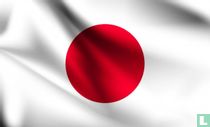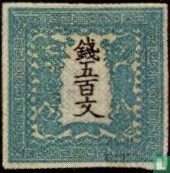Japan is een Oost-Aziatisch land tussen de Noordelijke Stille Oceaan en de Japanse Zee. Het keizerrijk Japan geeft postzegels uit sinds 1871. In 1875 ruilde Japan met de Sovjetunie Zuid-Sachalin tegen de Koerilen. In 1875 annexeerde Japan de Bonineilanden en in 1879 het koninkrijk Rioekioe. Na de Eerste Chinees-Japanse oorlog, in 1885, stond China Taiwan en de Pescadores af aan Japan. Na de Russisch-Japanse oorlog werd Zuid-Sachalin in 1905 opnieuw Japans. Op het einde van de 2de Wereldoorlog, in 1945, heroverden Russische troepen Zuid-Sachalin, dat samen met de Koerilen formeel aan de Sovjetunie werd toegewezen. Taiwan en de Pescadores werden in hetzelfde jaar heroverd door China en in 1952 formeel aan China afgestaan. Van 1945 tot 1952, werd de rest van Japan bezet door Amerikaanse troepen, Iwo Jima (de Bonin- en Vulkaaneilanden) tot 1968 en Okinawa (Rioekioe) tot 1972.
Japanse postzegels zijn "Miniature Ambassadors Of Culture" (The New Japan, Manchini Newspapers, 1958). Postzegels tonen een heel gamma van onderwerpen, waaronder gewoonten en gebruiken, industrie, landschappen en evenementen. Ze fungeren daarom als boegbeeld voor hun land van uitgifte.
Filatelie Japan
Japanse postzegels worden sinds 1871, op enkele uitzonderingen na, exclusief gedrukt door de drukkerij van het ministerie van financiën.
De Draken, de aardbeving-serie en diverse postzegels uitgegeven tijdens en na het einde van de oorlog werden gedrukt in particuliere drukkerijen.
Een belangrijke organisatie voor Japanse postzegelverzamelaars is de Japanese Philatic Society (JPS). Er is ook een internationaal platform voor verzamelaars van Japanse postzegels (de IJPS).
Zeldzame oude Japanse uitgiften vragen specifieke bewaringsomstandigheden. Kleine hoeveelheden van chemicaliën of polymeren die voorkomen in gewone albums kunnen deze beschadigen.
Oude Japanse vervalsingen zijn moeilijk te onderscheiden van de echte. Ze zijn ook meer dan 100 jaar oud en zijn op bijna hetzelfde papier en met bijna dezelfde inkt gedrukt als de echte.
Valuta
De nominale waarde op de eerste serie uit 1871 (4 postzegels, ongetand) is uitgedrukt in de japanse mon. Dit was de munteenheid die in de Muromachi periode werd gebruikt van 1336 tot 1870. 100 mon = 1 sen, 1 ryo/yen = 4 bu = 16 shu = 100 sen = 10.000 mon
Vanaf 27/06/1871 werd een nieuwe munteenheid yen in gebruik genomen: de yen (1 yen = 100 sen). Tot 1891 werd de mon nog gebruikt (betalen) naast de yen. De machines die de nieuwe munt moesten maken waren in 1871 nog niet aangekomen in Japan. Bij de postzegeluitgiftes vanaf 1872 werd wel al die nieuwe munteenheid gebruikt.
Er was een vaste wisselkoers: 1 sen = 100 mon, echter in het postkantoor (verkoop postzegels) werd een andere wisselkoers gebruikt: 1 sen = 96 mon.
Vanaf 01/01/1954 werd enkel nog yen gebruikt als valuta op Japanse postzegels. Dat wil zeggen dat een postzegel van Japan met 24.00 (24 groot en 00 klein met een lijntje er onder) als nominale waarde nooit moet gezocht worden in de cataloog nà 1953.
Jaartal bij afstempelingen
Datums (afstempelingen) op postwaardestukken of maakwerk moeten 'geïnterpreteerd' worden.
De Japanse jaartelling – in elk geval op afstempelingen – is anders dan de onze: dag en maand zijn sinds 1873 dezelfde als bij ons, maar bij de jaartelling wordt gerekend met het aantal jaren vanaf de troonsbestijging van de keizer.
De “Showa”-periode bv: Keizer Hirohito begon zijn regeerperiode eind december 1926: dat betekent dat de zegels vanaf dat moment in 1926 afgestempeld werden met Showa jaar 1. Zegels die in heel 1927 werden afgestempeld hebben Showa-jaar 2, enz., tot het overlijden van Hirohito in januari 1989 (Showa-jaar 64).
Daarna begon de regeerperiode van keizer Akihito, de Heisei-periode, en de jaartelling op afstempelingen begon opnieuw vanaf 7 januari 1989 met Heisei-jaar 1 (tot zijn abdicatie op 30 april 2019, Heisei-jaar 31).
Sindsdien regeert keizer Naruhito, en zijn regeerperiode heet Reiwa. Tot en met 31 december van het nu lopende jaar (2021) worden postzegels afgestempeld met Reiwa-jaar 3.
Een afstempeling “44.9.25”, op een postwaardestuk uit 1968 bv, wil zeggen 'afgestempeld op 25 september van Showa-jaar 44' – in onze tijdrekening is dat dus 1969. En dus niet in 1944.





























































